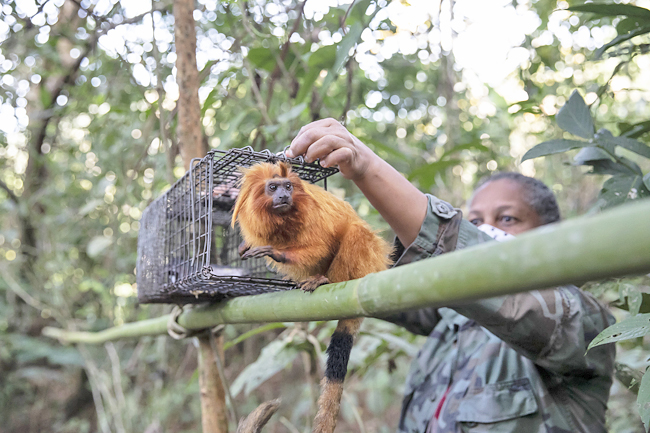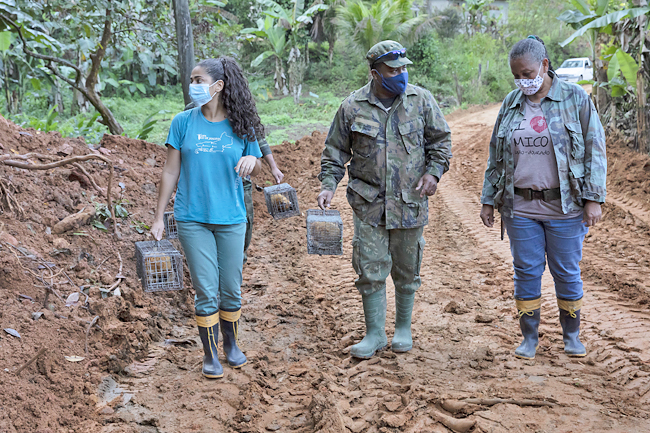Christina Larson
SILVA JARDIM, BRAZIL (AP) – In a small lab nestled in Brazil’s Atlantic Forest, researchers with gloved hands and masked faces cradle four tiny golden monkeys so a veterinarian can delicately slide a needle under the thin skin of each sedated animal’s belly.
The next morning, biologist Andréia Martins brings them to the precise spot where they were caught. She opens the wire cages and the monkeys dart out, hopping to a tree or the ground, ascending the canopy and regrouping as a family. They chatter noisily as they vanish into the rainforest.
This brief, strange encounter with humanity has been for the sake of their own health and the survival of their kind. The endangered wild monkeys, called golden lion tamarins, have now been vaccinated against yellow fever, part of a pathbreaking campaign to save a threatened species.
“Vaccinating wild animals for the sake of animals, not to protect humans, is novel,” said nonprofit Golden Lion Tamarin Association president Luís Paulo Ferraz.
When yellow fever began to spread in Brazil in 2016, resulting in over 2,000 human infections and around 750 deaths, it also quickly killed a third of the highly vulnerable tamarins, the majority of them in just a few months. So scientists in Brazil developed a yellow fever vaccine customised for the endangered monkeys.
The inoculation campaign started in 2021, and already over 300 tamarins have been vaccinated. The first such effort in Brazil, it raises vital questions about how far to go to save a species from extinction.




One of the traditional adages of conservation is “Leave it be”. But in an age when every corner of the globe is touched by human influence from melting icebergs to fragmented forests to plastic-filled oceans a new generation of scientists and environmentalists is increasingly calling for more interventionist approaches to save wild animals and ecosystems.
Conservation biologist at State University of Northern Rio de Janeiro Carlos R Ruiz-Miranda is among the scientists who have worked for over three decades to protect the golden lion tamarins, twice going to their rescue when extinction threatened. He said the vaccinations are the only option left: “Is it too extreme? Give me another alternative.”
Viruses have always abounded in nature. But humans have drastically changed the conditions and impacts of how they spread in wildlife. Epidemics can travel across oceans and borders faster than ever, and species already diminished by habitat loss and other threats are more at risk of being wiped out by outbreaks.
“Human activity is absolutely accelerating disease spread in non-human populations,” said environmental researcher at New York University Jeff Sebo, who was not involved in the Brazil project.
Southeastern Brazil was once covered by the rainforest, but today the undulating landscape is an uneven checkerboard of dark green jungle and grassy cow pastures – only 12 per cent of this rainforest remains.
Yet it’s the only place in the world that wild golden lion tamarins live.
The longstanding effort to save the charismatic monkeys – famous for their copper-coloured fur and small inquisitive faces framed by silken manes – included a pioneering captive breeding programme, coordinated among some 150 zoos worldwide. Many of those animals were then carefully released in Brazil starting in 1984, in cooperation with local landowners.
Then came yellow fever.
After the first lab-confirmed death of a tamarin from the virus in 2018, a census of the monkeys revealed the population of wild tamarins had dropped from around 3,700 to 2,500.
“This epidemic moved very quickly from north to south, across the country no wildlife does that,” said Ruiz-Miranda. “It’s people. They cross vast distances in buses, trains, planes.
They bring the disease with them.” Yellow fever is transmitted by mosquitoes, he explained, but highly mobile infected people spread the disease much farther and faster than insects alone.
“We realised that in five years, we could lose the entire population if we did nothing” said Ferraz, of the Golden Lion Tamarin Association.
At the time of the yellow fever outbreak, Marcos da Silva Freire was a deputy director of technological development at Brazil’s Oswaldo Cruz Foundation, which oversees vaccine diagnostics and production in the country.
Freire arranged with the Primate Center of Rio de Janeiro to begin trials of different doses of yellow fever vaccines on about 60 monkeys, close relatives of the tamarins, in January 2018.
A year later, he checked the level of antibodies in their blood. The vaccine appeared to work, without negative side effects. When the team got government approval to begin vaccinating wild monkeys, Freire supervised the first rounds of shots.
So far, they’ve vaccinated pver 300 tamarins and detected no adverse side effects. When they’ve caught and re-tested monkeys, 90 per cent to 95 per cent have shown immunity – similar to the efficacy of human vaccines.
The outbreak appears to have subsided, and the monitored monkey population has stabilised overall and even increased a little inside the Poço das Antas Biological Reserve.
While authorities elsewhere have inoculated animals to safeguard human health, it’s still very rare for scientists to administer vaccine injections to directly protect an endangered species.
“What are the unintended consequences of vaccination? You can’t always be certain,” said biologist and primatologist at Wake Forest University’s School of Medicine Jacob Negrey.
But increasingly scientists are examining the merits of vaccinating endangered wildlife, drawing up plans to potentially vaccinate tigers against canine distemper in Asia, chimpanzees against respiratory diseases in Africa, and koalas against chlamydia in Australia.
“There are people who say we shouldn’t touch nature, that we shouldn’t alter anything. But really, there are no pristine natural habitats left,” said disease ecologist and veterinarian at the University of Wisconsin-Madison Tony Goldberg, who supports vaccinating wildlife when it’s safe and practical.
“People are waking up to the magnitude of the problem and realising they have to do something.”






